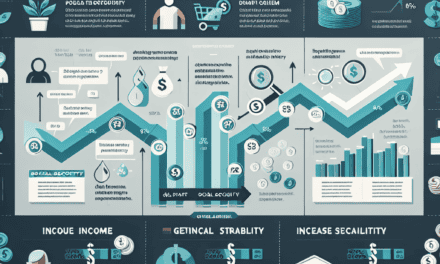“Investors Flock as 10-Year Treasury Yield Surges Past 4.5%!”
Introduction
The recent surge in the 10-year Treasury yield, surpassing the 4.5% mark, has captured the attention of investors worldwide, signaling a pivotal shift in the financial landscape. This development reflects a confluence of economic factors, including inflationary pressures, monetary policy adjustments, and evolving market dynamics. As yields rise, the allure of government bonds as a stable investment option grows, drawing interest from a diverse array of investors seeking to balance risk and return in an uncertain economic environment. The implications of this yield increase extend beyond the bond market, influencing equity valuations, corporate borrowing costs, and the broader economic outlook. As stakeholders navigate this changing terrain, the elevated 10-year Treasury yield serves as both a barometer of economic sentiment and a catalyst for strategic investment decisions.
Impact Of Rising Treasury Yields On Stock Market Investments
The recent surge in the 10-year Treasury yield, surpassing the 4.5% mark, has captured the attention of investors worldwide, prompting a reevaluation of stock market investments. This development is significant as it marks a shift in the financial landscape, influencing both individual and institutional investment strategies. As Treasury yields rise, they often signal changes in economic conditions, impacting the attractiveness of equities compared to fixed-income securities. Consequently, investors are now faced with the challenge of reassessing their portfolios to balance risk and return in light of these evolving dynamics.
To understand the implications of rising Treasury yields on stock market investments, it is essential to consider the relationship between bond yields and equity valuations. Typically, higher yields on government bonds make them more appealing to investors seeking stable returns, thereby reducing the relative attractiveness of stocks. This is because equities are generally perceived as riskier investments, and when safer alternatives like Treasuries offer competitive returns, investors may shift their capital away from stocks. As a result, stock prices can experience downward pressure, particularly in sectors that are sensitive to interest rate changes, such as utilities and real estate.
Moreover, the increase in Treasury yields can lead to higher borrowing costs for companies, as interest rates on corporate debt tend to rise in tandem with government bond yields. This scenario can affect corporate profitability, as businesses may face increased expenses related to debt servicing. Consequently, companies with high levels of leverage might find it more challenging to maintain their profit margins, potentially leading to a reevaluation of their stock valuations by investors. In turn, this can contribute to increased volatility in the stock market, as investors adjust their expectations based on the changing cost of capital.
In addition to these direct effects, rising Treasury yields can also influence investor sentiment and market psychology. As yields climb, they may be interpreted as a signal of tightening monetary policy by central banks, which could indicate efforts to curb inflationary pressures. This perception can lead to heightened uncertainty among investors, as they anticipate potential shifts in economic growth and inflation rates. Consequently, market participants may adopt a more cautious approach, favoring defensive stocks or sectors that are perceived as more resilient to economic fluctuations.
Despite these challenges, it is important to recognize that rising Treasury yields do not uniformly spell trouble for all stock market investments. Certain sectors, such as financials, may benefit from higher interest rates, as they can lead to improved net interest margins for banks and other financial institutions. Additionally, companies with strong balance sheets and low levels of debt may be better positioned to weather the impact of increased borrowing costs, making them attractive options for investors seeking stability in a volatile environment.
In conclusion, the surpassing of the 4.5% threshold by the 10-year Treasury yield presents both challenges and opportunities for stock market investors. While the allure of higher yields on government bonds may prompt some to reconsider their equity holdings, it is crucial to adopt a nuanced approach that takes into account the broader economic context and sector-specific dynamics. By carefully evaluating the potential impact of rising yields on different asset classes, investors can make informed decisions that align with their risk tolerance and long-term financial goals. As the financial landscape continues to evolve, staying attuned to these developments will be essential for navigating the complexities of the investment environment.
Strategies For Investors In A High-Yield Treasury Environment
As the 10-year Treasury yield surpasses the 4.5% mark, investors are increasingly drawn to the opportunities presented by this high-yield environment. This shift in the financial landscape prompts a reevaluation of investment strategies, as the allure of stable returns from government bonds becomes more pronounced. In this context, understanding the implications of rising yields and how to effectively navigate this environment is crucial for investors seeking to optimize their portfolios.
To begin with, the increase in Treasury yields signifies a change in the broader economic landscape. Higher yields often reflect expectations of rising inflation and interest rates, which can have a profound impact on various asset classes. For investors, this means reassessing the risk-reward balance of their portfolios. Traditionally, bonds are considered a safe haven, providing predictable income with relatively low risk. However, as yields rise, the prices of existing bonds tend to fall, potentially leading to capital losses for those holding older, lower-yielding bonds. Consequently, investors must weigh the benefits of higher income against the potential for price depreciation.
In light of these dynamics, one strategy that investors might consider is laddering their bond investments. This approach involves purchasing bonds with varying maturities, thereby spreading interest rate risk over time. By doing so, investors can benefit from higher yields on new bonds while mitigating the impact of price fluctuations on their existing holdings. Moreover, as bonds in the ladder mature, the proceeds can be reinvested in new, higher-yielding bonds, thus maintaining a steady income stream.
Another strategy worth considering is diversifying across different types of fixed-income securities. While U.S. Treasuries are often seen as the gold standard for safety, other fixed-income instruments, such as corporate bonds or municipal bonds, may offer attractive yields with varying degrees of risk. Corporate bonds, for instance, typically offer higher yields than Treasuries to compensate for the additional credit risk. Meanwhile, municipal bonds can provide tax advantages, which may enhance their appeal in a high-yield environment. By diversifying across these instruments, investors can potentially enhance their returns while managing risk.
Furthermore, it is essential for investors to remain vigilant about the broader economic indicators that influence interest rates and inflation. Keeping an eye on Federal Reserve policies, inflation data, and economic growth forecasts can provide valuable insights into future yield movements. This information can help investors make informed decisions about when to enter or exit positions in the bond market.
In addition to these strategies, investors should also consider their individual financial goals and risk tolerance. A high-yield environment may present opportunities for increased income, but it also requires a careful assessment of one’s investment objectives. For some, the stability and predictability of Treasury yields may align well with their goals, while others may seek higher returns through more aggressive strategies.
In conclusion, as the 10-year Treasury yield exceeds 4.5%, investors are presented with both opportunities and challenges. By employing strategies such as bond laddering, diversifying fixed-income holdings, and staying informed about economic trends, investors can navigate this high-yield environment effectively. Ultimately, aligning investment strategies with personal financial goals and risk tolerance will be key to capitalizing on the potential benefits of this evolving landscape.
Comparing Treasury Yields With Other Fixed-Income Investments
As the 10-year Treasury yield surpasses the 4.5% mark, investors are increasingly drawn to the potential benefits of this fixed-income investment. This development has sparked a renewed interest in comparing Treasury yields with other fixed-income options, as investors seek to optimize their portfolios in a fluctuating economic landscape. The allure of Treasury securities lies in their reputation for safety and reliability, backed by the full faith and credit of the U.S. government. However, the decision to invest in Treasuries over other fixed-income instruments requires a nuanced understanding of the broader market dynamics and individual investment goals.
To begin with, the rise in the 10-year Treasury yield is significant because it serves as a benchmark for various interest rates, influencing everything from mortgage rates to corporate bond yields. As yields increase, the price of existing bonds typically falls, which can create opportunities for investors to purchase these securities at a discount. This inverse relationship between bond prices and yields is a fundamental concept in fixed-income investing, and it underscores the importance of timing and market conditions in making investment decisions.
When comparing Treasury yields to other fixed-income investments, such as corporate bonds, municipal bonds, and certificates of deposit (CDs), several factors come into play. Corporate bonds, for instance, often offer higher yields than Treasuries to compensate for the additional risk associated with the issuing company’s creditworthiness. However, the recent uptick in Treasury yields narrows this yield spread, making Treasuries more attractive to risk-averse investors who prioritize capital preservation over higher returns.
Municipal bonds, on the other hand, provide tax advantages that can enhance their appeal, particularly for investors in higher tax brackets. The interest earned on most municipal bonds is exempt from federal income tax, and in some cases, state and local taxes as well. Despite these benefits, the current rise in Treasury yields may prompt some investors to reconsider their allocation to municipal bonds, especially if the after-tax yield on Treasuries becomes more competitive.
Certificates of deposit represent another fixed-income option, offering a fixed interest rate over a specified term. While CDs are insured by the Federal Deposit Insurance Corporation (FDIC) up to certain limits, their yields are generally lower than those of Treasuries, particularly in a rising interest rate environment. As a result, investors seeking higher returns may find the current Treasury yields more appealing, despite the lack of FDIC insurance.
In addition to yield considerations, liquidity is another crucial factor when comparing fixed-income investments. Treasuries are highly liquid, with a deep and active secondary market that allows investors to buy and sell with relative ease. This liquidity is a significant advantage over some corporate and municipal bonds, which may not trade as frequently or with the same level of transparency.
Ultimately, the decision to invest in Treasuries versus other fixed-income options depends on an investor’s risk tolerance, tax situation, and investment horizon. As the 10-year Treasury yield exceeds 4.5%, it presents a compelling opportunity for those seeking a balance between safety and return. However, it is essential for investors to conduct thorough research and consider their unique financial circumstances before making any investment decisions. By carefully weighing the pros and cons of each fixed-income option, investors can make informed choices that align with their long-term financial objectives.
Historical Analysis Of Treasury Yields And Investor Behavior

The recent surge in the 10-year Treasury yield, surpassing the 4.5% mark, has captured the attention of investors worldwide, prompting a renewed interest in government bonds. Historically, Treasury yields have served as a barometer for economic health and investor sentiment, influencing a wide array of financial decisions. To understand the current investor behavior, it is essential to delve into the historical context of Treasury yields and their impact on investment strategies.
In the past, periods of high Treasury yields have often coincided with robust economic growth and inflationary pressures. For instance, during the late 1970s and early 1980s, the U.S. experienced double-digit inflation, prompting the Federal Reserve to raise interest rates significantly. Consequently, Treasury yields soared, attracting investors seeking to hedge against inflation and secure higher returns. This historical precedent suggests that the current rise in yields may be indicative of similar economic dynamics, albeit in a different context.
Moreover, the relationship between Treasury yields and investor behavior is complex and multifaceted. When yields rise, the price of existing bonds typically falls, leading to potential capital losses for bondholders. However, higher yields also offer more attractive returns for new investors, prompting a shift in portfolio allocations. This dynamic is particularly relevant in the current environment, where investors are grappling with uncertainties surrounding inflation, monetary policy, and global economic growth.
In addition to these economic factors, the role of central banks cannot be overlooked. The Federal Reserve’s monetary policy decisions have a profound impact on Treasury yields, as they influence short-term interest rates and market expectations. In recent years, the Fed’s accommodative stance, characterized by low interest rates and quantitative easing, has kept yields relatively subdued. However, as the central bank signals a potential tightening of monetary policy to combat inflation, investors are recalibrating their expectations, leading to upward pressure on yields.
Furthermore, the global context plays a crucial role in shaping investor behavior. In an interconnected world, developments in major economies such as the European Union, China, and Japan can influence U.S. Treasury yields. For example, if foreign central banks adopt more restrictive monetary policies, it could lead to capital flows into U.S. Treasuries, driving yields higher. Conversely, geopolitical tensions or economic slowdowns abroad may prompt a flight to safety, resulting in increased demand for U.S. government bonds and downward pressure on yields.
As investors navigate this complex landscape, they must weigh the potential risks and rewards associated with higher Treasury yields. On one hand, rising yields may signal stronger economic growth and improved corporate earnings, benefiting equity markets. On the other hand, higher borrowing costs could dampen consumer spending and business investment, posing challenges for economic expansion. Consequently, investors are adopting a cautious approach, diversifying their portfolios to mitigate risks while seeking opportunities for enhanced returns.
In conclusion, the recent rise in the 10-year Treasury yield above 4.5% reflects a confluence of economic, monetary, and global factors that are reshaping investor behavior. By examining historical trends and understanding the underlying dynamics, investors can make informed decisions in an ever-evolving financial landscape. As they adapt to changing conditions, the interplay between Treasury yields and investor behavior will continue to be a critical area of focus, influencing market trends and economic outcomes in the years to come.
Risks And Rewards Of Investing In 10-Year Treasury Bonds
The recent surge in the 10-year Treasury yield, surpassing 4.5%, has captured the attention of investors worldwide. This development marks a significant shift in the financial landscape, offering both opportunities and challenges for those considering an investment in these government securities. As the yield on these bonds rises, so too does the potential for higher returns, making them an attractive option for investors seeking a stable income stream. However, it is crucial to weigh these potential rewards against the inherent risks associated with such investments.
To begin with, the appeal of 10-year Treasury bonds lies in their reputation as a low-risk investment. Backed by the full faith and credit of the U.S. government, these bonds are considered one of the safest investment vehicles available. This security is particularly appealing in times of economic uncertainty, as investors seek refuge from the volatility of the stock market. The recent increase in yield enhances this appeal, offering a more attractive return compared to other fixed-income securities.
Moreover, the higher yield on 10-year Treasuries can serve as a benchmark for other interest rates, influencing everything from mortgage rates to corporate borrowing costs. As yields rise, they can signal expectations of future economic growth and inflation, providing valuable insights for investors. This information can be instrumental in shaping investment strategies, as it helps investors anticipate changes in the broader economic environment.
However, while the potential for higher returns is enticing, it is essential to consider the risks associated with investing in 10-year Treasury bonds. One primary concern is interest rate risk. As interest rates rise, the price of existing bonds typically falls, which can lead to capital losses for bondholders who need to sell before maturity. This inverse relationship between interest rates and bond prices means that investors must be prepared for potential fluctuations in the value of their investments.
Additionally, inflation poses a significant risk to bond investors. If inflation rises faster than expected, the real return on these bonds could be eroded, diminishing their purchasing power over time. This risk is particularly pertinent in the current economic climate, where inflationary pressures are a growing concern. Investors must carefully assess their expectations for inflation and consider how it might impact their overall investment strategy.
Furthermore, while 10-year Treasury bonds are considered low-risk, they are not entirely without credit risk. Although the likelihood of a U.S. government default is extremely low, it is not impossible. Political gridlock and fiscal challenges could, in theory, impact the government’s ability to meet its debt obligations, albeit this remains a remote possibility.
In conclusion, the allure of investing in 10-year Treasury bonds with yields exceeding 4.5% is undeniable, offering a combination of safety and attractive returns. However, investors must remain vigilant, balancing these potential rewards against the risks of interest rate fluctuations, inflation, and credit concerns. By carefully considering these factors, investors can make informed decisions that align with their financial goals and risk tolerance. As always, diversification remains a key strategy, ensuring that investments in Treasury bonds are part of a broader, well-rounded portfolio.
How Rising Yields Affect Corporate Borrowing Costs
As the 10-year Treasury yield surpasses 4.5%, investors are increasingly drawn to the potential returns offered by government bonds. This shift in investor sentiment has significant implications for corporate borrowing costs, as the yield on Treasury securities often serves as a benchmark for various interest rates, including those applied to corporate debt. Consequently, when Treasury yields rise, the cost of borrowing for corporations tends to increase, affecting their financial strategies and overall economic activities.
To understand the impact of rising Treasury yields on corporate borrowing costs, it is essential to consider the relationship between government bonds and corporate debt. Treasury securities are considered one of the safest investments due to the backing of the U.S. government, and their yields are often used as a risk-free rate in financial models. When these yields increase, the spread between the risk-free rate and the yield on corporate bonds typically widens, reflecting the additional risk associated with lending to corporations. As a result, companies may face higher interest rates when issuing new bonds or refinancing existing debt, leading to increased borrowing costs.
Moreover, the rise in Treasury yields can influence corporate borrowing in several ways. First, higher borrowing costs can deter companies from taking on new debt, potentially slowing down expansion plans or delaying capital investments. This can have a ripple effect on the broader economy, as reduced corporate investment may lead to slower economic growth and lower job creation. Additionally, companies with existing variable-rate debt may experience an increase in interest expenses, which can strain their financial resources and impact profitability.
Furthermore, the impact of rising yields is not uniform across all sectors. Companies in capital-intensive industries, such as utilities and telecommunications, which rely heavily on debt financing, may be more adversely affected by increased borrowing costs. In contrast, firms with strong cash flows and lower debt levels may be better positioned to weather the impact of rising interest rates. This divergence can lead to shifts in investor preferences, as they may seek out companies with more robust financial health and lower exposure to interest rate fluctuations.
In addition to affecting corporate borrowing costs, rising Treasury yields can also influence investor behavior in the equity markets. As bond yields become more attractive, some investors may reallocate their portfolios, moving away from equities and into fixed-income securities. This shift can lead to increased volatility in the stock market, as changes in investor sentiment can drive fluctuations in stock prices. Companies may need to adjust their strategies to maintain investor confidence and attract capital in a more competitive environment.
In conclusion, the rise in the 10-year Treasury yield above 4.5% has far-reaching implications for corporate borrowing costs and the broader financial landscape. As companies navigate this changing environment, they must carefully consider their debt management strategies and assess the potential impact on their financial performance. By understanding the interplay between Treasury yields and corporate borrowing, businesses can make informed decisions to mitigate risks and capitalize on opportunities in a dynamic economic landscape. As investors continue to monitor these developments, the relationship between government bond yields and corporate debt will remain a critical factor in shaping the financial strategies of companies across various sectors.
Diversifying Portfolios Amidst Increasing Treasury Yields
As the 10-year Treasury yield surpasses the 4.5% mark, investors are increasingly drawn to the potential benefits of diversifying their portfolios amidst this evolving financial landscape. This notable rise in yield, a key indicator of economic sentiment and future interest rate expectations, has prompted a reevaluation of investment strategies among both institutional and individual investors. The allure of higher yields on government bonds, traditionally considered a safe haven, is compelling investors to reconsider their asset allocations, balancing risk and return in a period of economic uncertainty.
The increase in the 10-year Treasury yield can be attributed to several factors, including inflationary pressures, monetary policy adjustments, and shifts in global economic conditions. As inflation remains a persistent concern, central banks have signaled potential interest rate hikes to curb rising prices. Consequently, bond yields have adjusted upwards, reflecting the market’s anticipation of tighter monetary policy. This environment presents a unique opportunity for investors to capitalize on higher yields while maintaining a degree of safety in their portfolios.
In light of these developments, investors are exploring the role of Treasuries as a stabilizing force within their diversified portfolios. Traditionally, government bonds have been favored for their low risk and predictable returns, serving as a counterbalance to more volatile assets such as equities. With yields now exceeding 4.5%, Treasuries offer an attractive risk-adjusted return, prompting investors to increase their allocations to this asset class. This shift is particularly appealing to those seeking to mitigate risk amidst geopolitical tensions and economic uncertainties.
Moreover, the rising yields on Treasuries have implications for other asset classes, influencing investor behavior across the financial spectrum. For instance, higher bond yields can lead to increased borrowing costs for corporations, potentially impacting stock valuations. As a result, some investors may opt to reduce their exposure to equities, reallocating funds to fixed-income securities that now offer more competitive returns. This reallocation underscores the importance of a diversified investment strategy, enabling investors to navigate market fluctuations while pursuing long-term financial goals.
In addition to Treasuries, investors are also considering other fixed-income instruments, such as corporate bonds and municipal bonds, to enhance portfolio diversification. These alternatives provide varying degrees of risk and return, allowing investors to tailor their strategies to align with their risk tolerance and investment objectives. By incorporating a mix of fixed-income securities, investors can achieve a more balanced portfolio, reducing overall volatility and enhancing potential returns.
Furthermore, the current yield environment presents opportunities for international diversification. As U.S. Treasury yields rise, global investors may find American bonds more attractive, leading to increased capital inflows into the U.S. market. Conversely, U.S. investors might explore foreign bonds to capitalize on favorable exchange rates and yield differentials. This global perspective on diversification underscores the interconnectedness of financial markets and the importance of a comprehensive investment approach.
In conclusion, the surpassing of the 4.5% threshold by the 10-year Treasury yield has sparked renewed interest in government bonds as a cornerstone of diversified portfolios. As investors navigate the complexities of the current economic landscape, the strategic inclusion of Treasuries and other fixed-income assets can provide stability and enhance returns. By embracing a diversified approach, investors are better positioned to manage risk and seize opportunities in an ever-changing financial environment.
Q&A
1. **What is the significance of the 10-year Treasury yield exceeding 4.5%?**
The 10-year Treasury yield exceeding 4.5% is significant because it indicates higher returns on government bonds, attracting investors seeking stable income, and it can influence interest rates across the economy.
2. **Why are investors attracted to higher Treasury yields?**
Investors are attracted to higher Treasury yields because they offer a safer investment with better returns compared to other fixed-income securities, especially during uncertain economic times.
3. **How does a rise in Treasury yields affect the stock market?**
A rise in Treasury yields can negatively impact the stock market as it increases borrowing costs for companies and makes bonds more attractive compared to stocks, potentially leading to a shift in investment from equities to bonds.
4. **What impact does a higher 10-year Treasury yield have on mortgage rates?**
A higher 10-year Treasury yield typically leads to higher mortgage rates, as lenders adjust their rates to maintain a spread over the risk-free rate, making borrowing more expensive for homebuyers.
5. **How might the Federal Reserve respond to rising Treasury yields?**
The Federal Reserve might respond to rising Treasury yields by adjusting its monetary policy, potentially slowing down or pausing interest rate hikes to prevent excessive tightening of financial conditions.
6. **What are the risks associated with investing in Treasuries when yields are high?**
The risks include potential capital losses if yields continue to rise, as bond prices fall when yields increase, and the opportunity cost of missing out on higher returns from other investments if the economy improves.
7. **How do international investors view U.S. Treasuries when yields are high?**
International investors often view U.S. Treasuries as an attractive investment when yields are high due to the perceived safety and stability of U.S. government debt, along with favorable currency exchange rates.
Conclusion
The rise of the 10-year Treasury yield exceeding 4.5% has significantly attracted investors, signaling a shift in market dynamics. This increase suggests heightened expectations for future economic growth and potential inflationary pressures, prompting investors to seek the relative safety and stable returns of government bonds. As yields rise, the appeal of Treasuries grows, offering more attractive risk-adjusted returns compared to other asset classes. This trend may lead to a reallocation of portfolios, with investors balancing their exposure to equities and other riskier investments. The elevated yields also reflect the Federal Reserve’s monetary policy stance and its impact on interest rates, influencing investor sentiment and decision-making. Overall, the surpassing of the 4.5% threshold underscores the evolving economic landscape and its implications for investment strategies.





